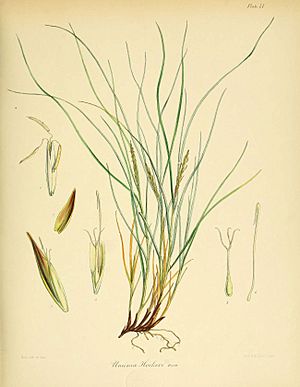Carex erebus facts for kids
Quick facts for kids Carex erebus |
|
|---|---|
 |
|
| Plate LI (artist: Fitch) | |
| Conservation status | |
|
Invalid status (NZ TCS)
|
|
| Scientific classification | |
| Genus: |
Carex
|
| Species: |
erebus
|
| Synonyms | |
|
Uncinia hookeri Boott |
|
Carex erebus is a special type of grass-like plant. It is often called Hookers bastard grass. This plant belongs to the sedge family. You can find it growing on islands near Antarctica. These islands are part of Australia and New Zealand.
Contents
Where Carex erebus Lives
This unique plant grows in a few specific places. In Australia, it is found on Macquarie Island. In New Zealand, you can spot it on Stewart Island, Antipodes Island, Auckland Islands, and Campbell Island. These islands are all in the southern part of the world.
How Carex erebus Got Its Name
Early Discovery
Carex erebus was first described in 1844. A botanist named Francis Boott gave it the name Uncinia hookeri. This happened in a book called Flora Antarctica. The book was written by another famous botanist, Joseph Dalton Hooker. Joseph Hooker collected this plant himself. He found it on the Auckland Islands during a big trip.
The Ship That Gave It a Name
Joseph Hooker was on an important journey from 1839 to 1843. This was the Antarctic expedition. He sailed on a ship called HMS Erebus. This ship is why the plant got its current name.
Why the Name Changed
In 2015, scientists decided to group some plants differently. The group of plants called Uncinia was merged into the larger group called Carex. This meant Uncinia hookeri needed a new name. There was already a plant named Carex hookeri from 1837. So, they chose a new name for our plant: erebus. This new name honors the ship HMS Erebus. It reminds us of the important journey when the plant was first found.
How Carex erebus is Protected
Conservation Status in New Zealand
In New Zealand, Carex erebus is considered "At Risk - Naturally Uncommon". This means it is not very common. It is naturally rare because it only grows in a few places. This status was given under the New Zealand Threat Classification System. It was first listed this way in 2009 and 2012. This classification was confirmed again in 2018.
Secure in Other Places
Even though it's rare in New Zealand, scientists say it is "secure overseas". This means it is doing well in other places where it grows, like on Macquarie Island in Australia. Its small range is the main reason it is considered "At Risk" in New Zealand.

